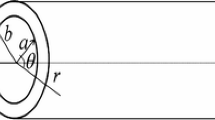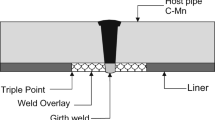Abstract
Despite the success of guided wave ultrasonic inspection for internal defect detection in steel pipes, its application on polyethylene (PE) pipe remains relatively unexplored. The growth of internal cracks in PE pipe severely affects its pressure-holding capacity, hence the early detection of internal cracks is crucial for effective pipeline maintenance strategies. This study extends the scope of guided wave-based ultrasonic testing to detect the growth of internal cracks in a natural gas distribution PE pipe. Laboratory experiments and a finite element model were planned to study the wave-crack interaction at different stages of axially oriented internal crack growth with a piezoceramic transducer-based setup arranged in a pitch-catch configuration. Mode dispersion analysis supplemented with preliminary experiments was performed to isolate the optimal inspection frequency, leading to the selection of the T(0,1) mode at 50-kHz for the investigation. A transmission index based on the energy of the T(0,1) mode was developed to trace the extent of simulated crack growth. The findings revealed an inverse linear correlation between the transmission index and the crack depth for crack growth beyond 20% crack depth.
Similar content being viewed by others
References
Azad M and Tavallali M (2019), “A Novel Computational Supplement to an IR-Thermography Based Non-Destructive Test of Electrofusion Polyethylene Joints,” Infrared Physics & Technology, 96: 30–38.
Barker MB, Bowman J and Bevis M (1983), “The Performance and Causes of Failure of Polyethylene Pipes Subjected to Constant and Fluctuating Internal Pressure Loadings,” Journal of Materials Science, 18: 1095–1118.
Bocchini P, Marzani A and Viola E (2011), “Graphical User Interface for Guided Acoustic Waves,” Journal of Computing in Civil Engineering, 25(3): 202–210.
Brown N, Donofrio J and Lu X (1987), “The Transition Between Ductile and Slow-Crack-Growth Failure in Polyethylene,” Polymer, 28(8): 1326–1330.
Chan CW and Cawley P (1998), “Lamb Waves in Highly Attenuative Plastic Plates,” The Journal of the Acoustical Society of America, 104(2): 874–881.
Chudnovsky A, Zhou ZW, Zhang HY and Sehanobish K (2012), “Lifetime Assessment of Engineering Thermoplastics,” International Journal of Engineering Science, 59: 108–139.
Demčenko A, Akkerman R, Nagy PB and Loendersloot R (2012), “Non-Collinear Wave Mixing for Non-Linear Ultrasonic Detection of Physical Ageing in PVC,” Ndt & E International, 49: 34–39.
Ghavamian A, Mustapha F, Hang BT, et al. (2018), “Detection, Localisation and Assessment of Defects in Pipes Using Guided Wave Techniques: A Review,” Sensors, 18(12): 4470.
Hagglund F, Spicer M and Troughton M (2012), “Phased Array Ultrasonic Testing of Welded Joints in Plastic (PE) Pipes,” 6th Middle East Nondestructive Testing Conference & Exhibition, Kingdom of Bahrain.
Hamouda HBH, Simoes-betbeder M, Grillon F, et al. (2001), “Creep Damage Mechanisms in Polyethylene Gas Pipes,” Polymer, 42(12): 5425–5437.
Harvey JA (2005), Chemical and Physical Aging of Plastics, Handbook of Environmental Degradation of Materials, William Andrew Publishing, UK, pp. 153–163.
Hong XB, Lin XH, Yang B and Li MD (2017), “Crack Detection in Plastic Pipe Using Piezoelectric Transducers Based on Nonlinear Ultrasonic Modulation,” Smart Materials and Structures, 26(10): 104012.
Horvath I (1979), “Radiographic Testing of Welded Joints of High-Density Polyethylene Pipes,” ZlS-Mitteilungen, 21(7): 723–732.
Hu C and Chen XZ (2014), “A Review and Preliminary Experiment on Application of Infrared Thermography in Welding,” International Conference Intelligence and Automation, Springer.
Hutař P, Ševčik M, Nahlik L, et al. (2011), “A Numerical Methodology for Lifetime Estimation of HDPE Pressure Pipes,” Engineering Fracture Mechanics, 78(17): 3049–3058.
Kalyanam S, Krishnaswamy P, Shim DJ, Hioe Y, et al. (2013), “Assessment of Slow Crack Growth Test Methodologies Used to Predict Service Life of High Density Polyethylene Piping,” Pressure Vessels and Piping Conference, American Society of Mechanical Engineers, USA.
Khelif R, Chateauneuf A and Chaoui K (2007), “Reliability-Based Assessment of Polyethylene Pipe Creep Lifetime,” International Journal of Pressure Vessels and Piping, 84(12): 697–707.
Lai HS, Tun NN, Kil SH, et al. (2016), “Effect of Defects on the Burst Failure of Butt Fusion Welded Polyethylene Pipes,” Journal of Mechanical Science and Technology, 30: 1973–1981.
Lowe S, Lais H, Paruchuri V, et al. (2020), “Application of Ultrasonic Guided Waves for Inspection of High Density Polyethylene Pipe Systems,” Sensors, 20(11): 3184.
Luo XP, Lu SL, Shi JF, et al. (2015), “Numerical Simulation of Strength Failure of Buried Polyethylene Pipe Under Foundation Settlement,” Engineering Failure Analysis, 48: 144–152.
Majid F, Abderazzak O, Mohamed B and Mohamed E (2017), “Mechanical Behavior Prediction of PPR and HDPE Polymers Through Newly Developed Nonlinear Damage-Reliability Models,” Procedia Structural Integrity, 3: 387–394.
Mehrabi M, Soorgee M, Habibi H and Kappatos V (2022), “An Experimental Technique for Evaluating Viscoelastic Damping Using Ultrasonic Guided Waves,” Ultrasonics, 123: 106707.
Na S, Nguyen L, Spatari S, et al. (2016), “Evaluating the Effect of Nanoclay and Recycled HDPE on Stress Cracking in HDPE Using J-Integral Approach,” ANTEC, 2016, Indianapolis, IN, USA.
Palermo G and Busko K (2015), “Managing Aldyl-A Polyethylene Pipe in Avista’s Distribution System,” Pipeline & Gas Journal’s 2015 Plastic Pipe Reprot, pp. 49–56.
Palermo G, Vibien P, Oliphant K and Kosari T (2007), “New Test Method to Determine Effect of Recycled Materials on Corrugated HDPE Pipe Performance as Projected by Rate Process Method,” Plastics, Rubber and Composites, 36(5): 213–218.
Pilarski A, Ditri J and Rose J (1993), “Remarks on Symmetric Lamb Waves with Dominant Longitudinal Displacements,” The Journal of the Acoustical Society of America, 93(4): 2228–2230.
Qin YK, Shi JF, Zheng JY and Hou DS (2019), “An Improved Phased Array Ultrasonic Testing Technique for Thick-Wall Polyethylene Pipe Used in Nuclear Power Plant,” Journal of Pressure Vessel Technology, 141(4): 041403.
Rojhani M, Moradi M and Derakhshani A (2022), “Innovative Mitigation Method for Buried Pipelines Crossing Faults,” Earthquake Engineering and Engineering Vibration, 21(4): 1089–1101.
Rose JL (1999), Ultrasonic Waves in Solid Media, Cambridge University Press, UK.
Schramm D (2006), “PE-RT: A New Class of Polyethylene for Industrial Pipes,” 25th International Conference on Offshore Mechanics and Arctic Engineering, Humburg, Germany, pp. 513–521.
Schroder CT and Scott WR (2000), “Three-Dimensional FDTD Model to Study the Elastic-Wave Interaction with Buried Land Mines,” IGARSS 2000, IEEE 2000 International Geoscience and Remote Sensing Symposium, Taking the Pulse of the Planet: The Role of Remote Sensing in Managing the Environment. Proceedings (Cat. No. 00CH37120), Honolulu, HI, USA, 1: 26–28.
Schulte et al. (2006), “A Vision Becomes True-50 Years of Pipes Made from High Density Polyethylene,” Proceedings of Plastic Pipes XIII.
Shafeek HI, Gadelmawla ES, Abdel-Shafy AA and Elewa IM (2004), “Assessment of Welding Defects for Gas Pipeline Tadiographs Using Computer Vision,” NDT & E International, 37(4): 291–299.
Shah J, El-Hawwat S and Wang H (2023), “Guided Wave Ultrasonic Testing for Crack Detection in Polyethylene Pipes: Laboratory Experiments and Numerical Modeling,” Sensors, 23(11): 5131.
Šindelář P, Nezbedová E, Šimková P, Buráň Z and Bohaty P (2005), “Effect of Structural Parameters on Rapid Crack Propagation and Slow Crack Growth in High Density Polyethylene Pipeline Materials,” Plastics Rubber and Composites, 34(7): 329–333.
Smith (2011), Abaqus 6.11. Dassault Systemes Simulia Corporation, Providence, RI, USA.
Vogt H, Enderle H-F, Schulte U and Hessel J (2009), “Thermal Ageing of PE 100 Pipes for Accelerated Lifetime Prediction Under Service Conditions,” International Plastic Pipe Exchange Conference, Washington, D.C., USA.
Wang H, Shah J, Hawwat SE, Huang QD, et al. (2024), “A Comprehensive Review of Polyethylene Pipes: Failure Mechanisms, Performance Models, Inspection Methods, and Repair Solutions,” Journal of Pipeline Science and Engineering, Published online.
Zha SX, Lan HQ and Huang H (2022), “Review on Lifetime Predictions of Polyethylene Pipes: Limitations and Trends,” International Journal of Pressure Vessels and Piping, 198: 104663.
Zheng XT, Wang JQ and Chen HF (2020), “Burst Pressures of High-Density Polyethylene Pipes Considering the Notch Effect: Testing and Prediction,” Journal of Testing and Evaluation, 48(6): 20180185.
Zhu XW, Pan JP and Tan LJ (2013), “Microwave Scan Inspection of HDPE Piping Thermal Fusion Welds for Lack of Fusion Defect,” Applied Mechanics and Materials, 333: 1523–1528.
Acknowledgment
The authors acknowledge the financial support provided by USDOT Pipeline and Hazardous Materials Safety Administration (PHMSA) through the Competitive Academic Agreement Program (CAAP).
Author information
Authors and Affiliations
Corresponding author
Rights and permissions
About this article
Cite this article
Shah, J.K., Wang, H. & El-Hawwat, S. Detection of internal crack growth in polyethylene pipe using guided wave ultrasonic testing. Earthq. Eng. Eng. Vib. 23, 319–329 (2024). https://doi.org/10.1007/s11803-024-2238-8
Received:
Accepted:
Published:
Issue Date:
DOI: https://doi.org/10.1007/s11803-024-2238-8




